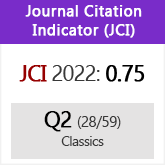¿Seducción o prostitución? Lisias, Defensa por el homicidio de Eratóstenes
DOI:
https://doi.org/10.3989/emerita.2017.02.1613Palabras clave:
Lisias, prostitución, adulterio, oratoria, ciudadaníaResumen
Proponemos una nueva interpretación del discurso primero de la colección de Lisias, Defensa por el homicidio de Eratóstenes; pensamos que el adulterio que causó la muerte de Eratóstenes fue consentido y, por tanto, se trata de un caso que está más cerca de la prostitución que de la seducción de una joven esposa por un casanova. Creemos que así se explican mejor muchas de las circunstancias de las que se nos habla en la narración y la argumentación del discurso. Se pone en relación esta interpretación con la normativa legal conocida que incide en la prostitución y los trabajos recientes sobre la prostitución en Grecia, incluida la de mujeres ciudadanas, que debía de ser más frecuente de lo que suele pensarse.
Descargas
Citas
Burkert, W. 1985: Greek Religion: Archaic and Classical, Oxford.
Cantarella, E. 1991: «Moicheia. Reconsidering a Problem», en Gagarin, M. (ed.), Symposion 1990. Papers on Greek and Hellenistic Legal History, Colonia, pp. 289-296.
Carey, C. 1995: «Rape and Adultery in Athenian Law», CQ 45, pp. 407-417. https://doi.org/10.1017/S0009838800043482
Carey, C. 2007: Lysiae orationes cum fragmentis, Oxford.
Cohen, D. 1991: Law, Sexuality, and Society: The Enforcement of Morals in Classical Athens, Cambridge.
Cohen, D. 1993: «Consent and Sexual Relations in Classical Athens», en Laiou, A. E. (ed.), Consent and Coercion to Sex and Marriage in Ancient and Medieval Societies, Washington, pp. 5-16.
Cohen, E. E. 2003: «Athenian Prostitution as a Liberal Profession», en Bakewell, G. W. y Sickinger, J. P. (eds.), Gestures. Essays in Ancient History, Literature, and Philosophy presented to Alan L. Boegehold, Oxford, pp. 214-236. PMid:12611751
Cohen, E. E. 2006: «Free and Unfree Sexual Work: An Economic Analysis of Athenian Prostitution», en Faraone, Ch. A. y Mcclure, L. K. (eds.), Prostitutes and Courtesans in the Ancient World, Londres, pp. 95-124.
Cohen, E. E. 2015: Athenian Prostitution. The Business of Sex, Oxford.
Cole, S. G. 1984: «Greek Sanctions against sexual assault», CPh 79, pp. 97-113. https://doi.org/10.1086/366842
Davidson, J. 1998: Courtesans and Fishcakes. The Consuming Passions of Classical Athens, Londres.
Davidson, J. 2004: «Liaisons dangereuses: Aphrodite and the hetaira», JHS 124, pp. 169-173. https://doi.org/10.2307/3246158
Dilts, M. R. 2009: Demosthenis Orationes IV, Oxford.
Glazebrook, A. 2005: «The Making of a Prostitute: Apollodoros's Portrait of Neaira », Arethusa 38, pp. 161-187. https://doi.org/10.1353/are.2005.0009
Glazebrook, A. 2006a: «Prostituting Female Kin (Plut. Sol. 23.1-2)», Dike 8, pp. 33-54.
Glazebrook, A. 2006b: «The Bad Girls of Athens. The Image and Function of Hetairai in Judicial Oratory», en Faraone, Ch. A. y Mcclure, L. K. (eds.), Prostitutes and Courtesans in the Ancient World, Londres, pp. 125-138.
Glazebrook, A. 2011: «Porneion : Prostitution in Athenian Civic Space», en Glazebrook, A. y Henry, M. M. (eds.), Greek Prostitutes in the ancient Mediterranean, 800 BCE-200 CE, Madison, pp. 34-59.
Glazebrook, A. 2014: «Sexual Rhetoric: From Athens to Rome» en Hubbard, Th. K., A Companion to Greek and Roman Sexualities, Malden MA, Oxford, pp. 431-444.
Glazebrook, A. y Olson, K. 2014: «Greek and Roman Marriage», en Hubbard, Th. K., A Companion to Greek and Roman Sexualities, Malden MA, Oxford, pp. 69-92.
Halperin, D. M. 1990: One Hundred Years of Homosexuality, New York.
Hamel, D. 2003: Trying Neaira. The True Story of a Courtesan's Scandalous Life in Ancient Greece, New Haven.
Hamel, D. 2016: Killing Eratosthenes. A True Crime Story from Ancient Athens, sin mención de lugar, citado por las posiciones de la version digital de Amazon.
Harris, E. M. 1990: «Did the Athenians Regard Seduction as a Worse Crime than Rape?», CQ 40, pp. 370-377. https://doi.org/10.1017/S0009838800042956
Johnstone, S. 2002: «Apology for the Manuscript of Demosthenes 59.67», AJPh 123, pp. 229-256. https://doi.org/10.1353/ajp.2002.0024
Just, R. 1989: Women in Athenian Law and Life, Londres. https://doi.org/10.4324/9780203317341
Kapparis, K. 1999: Apollodoros 'Against Neaira' [D. 59], Berlín.
MacDowell, D. 1999 (=1963): Athenian Homicide Law in the Age of the Orators, Manchester.
McGinn, Th. A. J. 2014: «Prostitution: Controversies and New Approaches», en Hubbard, Th. K., A Companion to Greek and Roman Sexualities, Malden MA, Oxford, pp. 83-100.
Nowak, M. 2010: «Defining prostitution in Athenian legal rhetorics», Revue d'Histoire du Droit 78, 183-197. https://doi.org/10.1163/157181910X487369
Paoli, U. E. 1950: «Il reato di adulterio [moicheia] in diritto attico», Studia et documenta historiae et iuris 16, pp. 132-182.
Roy, J. 1997: «An Alternative Sexual Morality for Classical Athenians», Greece & Rome 44, pp. 11-22. https://doi.org/10.1093/gr/44.1.11
Schmitz, W. 1997: «Der nomos moicheias-Das athenische Gesetz über den Ehebruch », Zeitschrift der Savigny-Stiftung für Rechtsgeschichte: Romanistische Abteilung 114, pp. 45-144. https://doi.org/10.7767/zrgra.1997.114.1.45
Todd, S. C. 1993: The Shape of Athenian Law, Oxford.
Todd, S. C. 2007: A Commentary on Lysias. Speeches 1-11, Oxford.
Viano, C. 2011: «Théorie éthique et pratique judiciaire: passions et délits passionnels chez Platon, Aristote et Lysias», Metis 9, pp. 101-121. https://doi.org/10.4000/books.editionsehess.2591
Descargas
Publicado
Cómo citar
Número
Sección
Licencia
Derechos de autor 2017 Consejo Superior de Investigaciones Científicas (CSIC)

Esta obra está bajo una licencia internacional Creative Commons Atribución 4.0.
© CSIC. Los originales publicados en las ediciones impresa y electrónica de esta Revista son propiedad del Consejo Superior de Investigaciones Científicas, siendo necesario citar la procedencia en cualquier reproducción parcial o total.Salvo indicación contraria, todos los contenidos de la edición electrónica se distribuyen bajo una licencia de uso y distribución “Creative Commons Reconocimiento 4.0 Internacional ” (CC BY 4.0). Puede consultar desde aquí la versión informativa y el texto legal de la licencia. Esta circunstancia ha de hacerse constar expresamente de esta forma cuando sea necesario.
No se autoriza el depósito en repositorios, páginas web personales o similares de cualquier otra versión distinta a la publicada por el editor.














